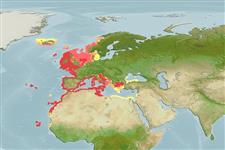Classification / Names
Common names from other countries
Main reference
Size / Weight / Age
Max length : 27.5 cm SL male/unsexed; (Ref. 74552); common length : 20.0 cm SL male/unsexed; (Ref. 188); max. reported age: 15 years (Ref. 35388)
Length at first maturity
Lm 14.8 range ? - ? cm
Environment
Marine; freshwater; brackish; pelagic-neritic; oceanodromous (Ref. 51243); depth range 10 - 100 m (Ref. 5286), usually 25 - 100 m (Ref. 54866)
Climate / Range
Subtropical, preferred 16°C (Ref. 107945); 68°N - 14°N, 32°W - 43°E (Ref. 54866)
Distribution
Northeast Atlantic: Iceland (rare) and North Sea, southward to Bay de Gorée, Senegal. Mediterranean (common in the western part and in Adriatic Sea, rare in the eastern part), Sea of Marmara and Black Sea.
Countries | FAO areas | Ecosystems | Occurrences | Introductions
Short description
Dorsal
spines
(total): 0;
Dorsal
soft rays
(total): 13-21;
Anal
spines: 0;
Anal
soft rays: 12 - 23. Body sub-cylindrical, belly rather rounded (but more compressed in juveniles). Hind margin of gill opening smoothly rounded (without fleshy outgrowths) ; 3 to 5 distinct body striae radiating downward on lower part of operculum; lower gill rakers not becoming shorter at angle of first gill arch, the upper series not overlapping the lower. Last 2 anal fin rays enlarged.
IUCN Red List Status (Ref. 115185)
Threat to humans
Harmless
Human uses
Fisheries: highly commercial
Tools
Special reports
Download XML
Internet sources
Estimates of some properties based on models
Phylogenetic diversity index
PD50 = 1.0000 many relatives (e.g. carps) 0.5 - 2.0 few relatives (e.g. lungfishes)
Trophic Level
3.1 ±0.1 se; Based on diet studies.
Resilience
Medium, minimum population doubling time 1.4 - 4.4 years (K=0.23-0.5; tm=1-2; tmax=15)
Vulnerability
Low to moderate vulnerability (27 of 100)
Price category
